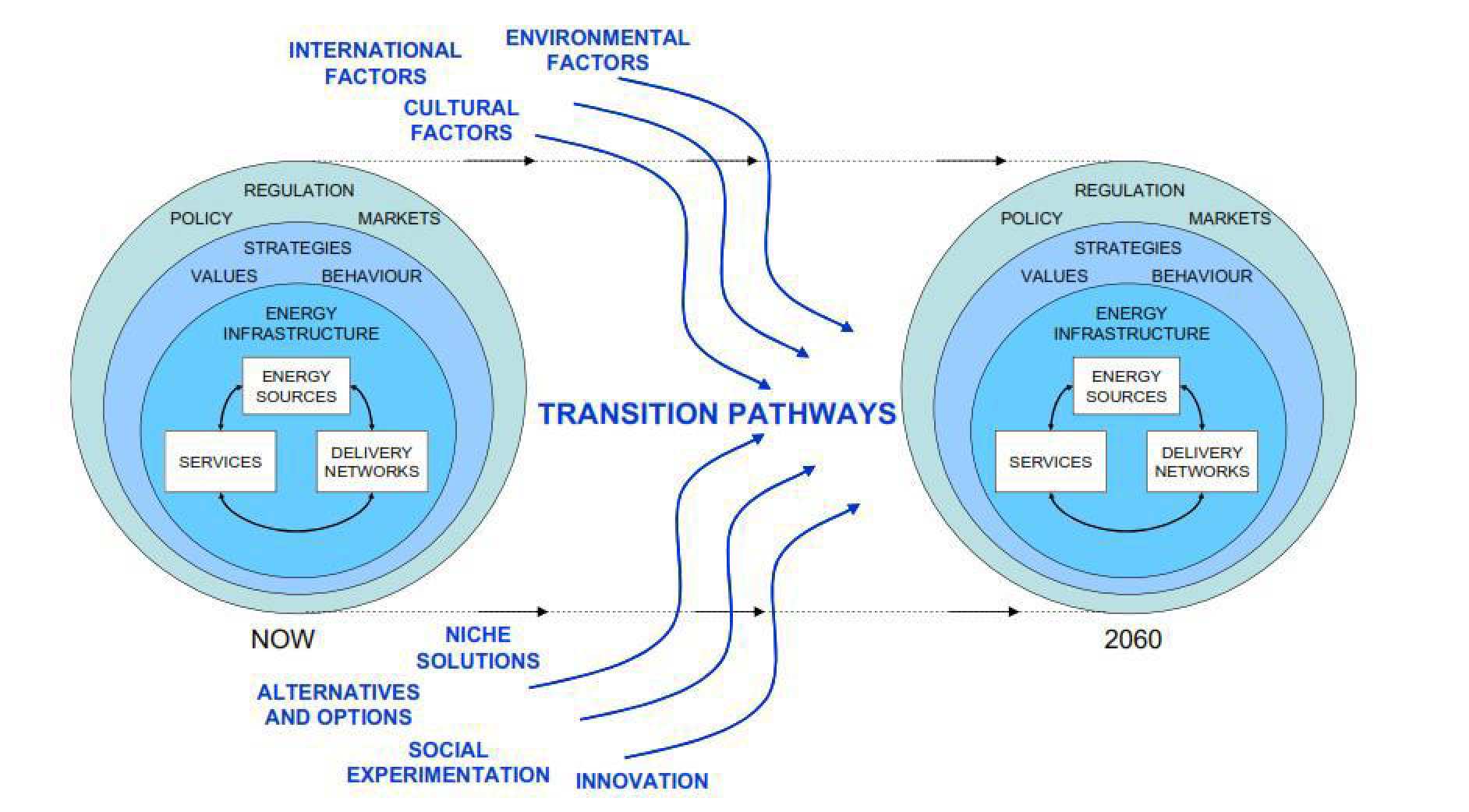EPSRC Realising Transition Pathways
The project involves new studies of historical transition experience, of 'branching points' on pathways, strategic issues (including horizon scanning of medium-term technological developments on the supply-side, the network infrastructure and the demand-side), as well as network, market simulation and behavioural modelling, with 'whole systems' appraisal' of key energy technologies and the full pathways within a 'sustainability framework'. There are nine universities in the UK including Imperial College London involved in this EPSRC funded project (phase I: 1998- 2012, phase 2: 2012-2016).

Figure 1 Possible Transition Pathways and the Factors that Influence them (Source: Foxon et al., 2010 [1])
The figure above depicts factors that characterise the technological, infrastructural and institutional aspects of energy systems and influences on possible transition pathways (this figure is informed by an international research programme on ‘transitions in socio-technical systems’). These influences flow from both ‘bottom up’, through social and technological innovation and experimentation, and from ‘top down’, through wider international, environmental and cultural factors. The project team examine the dynamics of a transition to a UK low carbon electricity system by:
- Analysing actors' choices and decisions within past, current and prospective dynamic changes in electricity supply and demand systems, including learning from analogous socio-technical systems
- Undertaking detailed analysis of social, behavioural and technical drivers and implications of demand side responses and their integration into electricity systems
- Undertaking techno-economic system modelling and energy and environmental assessments of the developments in electricity supply (including transmission and distribution networks) required to meet this responsive demand.
The Imperial’s work focuses on the following two topics:
- The development of whole system based approach and studies to identify the role and quantify the value of Demand Side Response and storage technologies in various transition pathways. DSR and storage could bring significant benefits to several sectors of the electricity industry, including distribution networks, transmission networks and generation system operation and investment. The key research challenge is to manage the synergies and conflicts between distribution network, energy supply, transmission network, and the EU interconnection objectives when allocating DSR flexibility and to quantify the value and the importance of DSR and storage deployment in different transition pathways.
- The development of a modelling framework to assess the effects of alternative market models and designs of subsidy mechanisms in low carbon generation coupled with different forms of policy measures such as Emissions Performance Standard and network pricing arrangements.
Key publications:
- Evelina Trutnevyte, John Barton, Áine O’Grady, Damiete Ogunkunle, Danny Pudjianto, Elizabeth Robertson, “Linking a storyline with multiple models: a cross-scale study of the UK power system transition”, Technological Forecasting & Social Change: Elsevier, vol. 89, 2014, pp. 26-42.
- D. Pudjianto, M. Aunedi, P. Djapic, and G. Strbac, "Whole-Systems Assessment of the Value of Energy Storage in Low-Carbon Electricity Systems," Smart Grid, IEEE Transactions on, vol. 5, pp. 1098-1109, 2013.
- D. Pudjianto, P. Djapic, M. Aunedi, C. K. Gan, G. Strbac, S. K. Huang, and D. Infield, "Smart control for minimizing distribution network reinforcement cost due to electrification," Energy Policy, vol. 52, Jan 2013, pp. 76-84.
Website: http://www.realisingtransitionpathways.org.uk/
Lead Researcher: Dr Danny Pudjianto (d.pudjianto@imperial.ac.uk)
List of other CAP researchers:
- Dr Marko Aunedi (m.aunedi@imperial.ac.uk)
- Prof. Goran Strbac
List of external people: the list of researchers involved in this project can be found at
[1] Foxon, T.J., Hammond, G.P. and Pearson, P.J., 2010. Developing transition pathways for a low carbon electricity system in the UK, Technological Forecasting and Social Change, 77 (8): 1203-1213[http://dx.doi.org/10.1016/j.techfore.2010.04.002].


